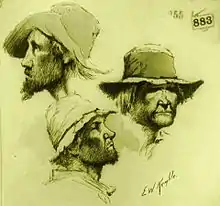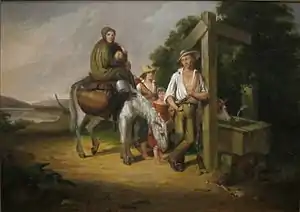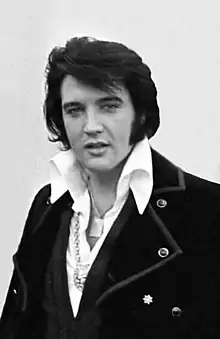Poor White
Poor White is a sociocultural classification used to describe economically disadvantaged Whites in the English-speaking world, especially White Americans with low incomes.
 Portrayals of Poor Whites in U.S. state of Georgia, as illustrated by E. W. Kemble, circa 1891 | |
| Regions with significant populations | |
|---|---|
| Southern United States | |
| Related ethnic groups | |
| White Southerners, Mountain white, White Americans |
In the United States, Poor White is the historical classification for an American sociocultural group,[1] of generally Western and/or Northern European descent, with many being in the Southern United States and Appalachia regions. They were first classified as a social caste[2][3] in the Antebellum South,[4] consisting of white, agrarian, economically disadvantaged laborers or squatters, who usually owned neither land nor slaves.[5][6][7]
In the British Commonwealth, the term was historically used to describe lower-class whites,[8][9] notably in the context of the "poor white problem" in South Africa.[10][11] The term has also been occasionally used in a British context since the second half of the 20th century to distinguish poor white Britons from lower-class Black and Asians in Britain.[12][13]
United States
Identity

Throughout American history the Poor Whites have regularly been referred to by various terms;[14] the majority of which are often considered disparaging. They have been known as "rednecks" (especially in modern context), "hillbillies" in Appalachia, "crackers" in Texas, Georgia, and Florida, "Hoosier" in St. Louis, Missouri, and "poor white trash". In the past, the use of the term "Poor White" by the white Southern elite was to distance themselves from elements of society they viewed as "undesirable", "lesser" or "antisocial." It denoted a separation, reflective of a social hierarchy, with "poor" used to demonstrate a low position, while "white" was used to subjugate rather than to classify. Author Wayne Flynt in his book, Dixie's Forgotten People: The South's Poor Whites (2004), argues that "one difficulty in defining poor whites stems from the diverse ways in which the phrase has been used. It has been applied to economic and social classes as well as to cultural and ethical values."[1] While other regions of the United States have white people who are poor, this does not have the same meaning as the Poor White in the South. In context, the Poor White refers to a distinct sociocultural group, with members who belong to families with a history of multi-generational poverty and cultural divergence.
History
Much of the character and condition of Poor Whites is rooted in the institution of slavery. Rather than provide wealth as it had for the Southern elite, in stark contrast, slavery considerably hindered progress of whites who did not own slaves by exerting a crowding-out effect, eliminating free labor in the region. This effect, compounded by the area's widespread lack of public education and its general practice of endogamy, prevented low-income and low-wealth free laborers from moving to the middle class.
Many fictional depictions in literature used poor whites as foils in reflecting the positive traits of the protagonist against their perceived "savage" traits.[15][16] In her novel Dred, Harriet Beecher Stowe illustrates a commonly held stereotype that marriage to them results in generic degradation and barbarism of the better class.[16]
For the sake of dear dependents the will forces the weary muscles to act and knits the relaxed nerves. Surely, fatally, the joy dies out of the eyes of childhood, girlhood is but a flickering shadow, and maturity an enforced decrepitude, a lingering old age, a quenching of the fires of life before they half burn.[17]
Clare de Graffenreid, "The Georgia Cracker in the Cotton Mills"
During the American Civil War, the Poor White comprised a majority of the combatants in the Confederate Army; afterwards, many labored in the rural South as sharecroppers. During the nadir of American race relations at the turn of the 20th century, intense violence, defense of honor and white supremacy flourished[18] in a region suffering from a lack of public education and competition for resources. Southern politicians of the day built on conflict between Poor Whites and African Americans in a form of political opportunism.[14][19][20] As John T. Campbell summarizes in The Broad Ax in 1906:
In the past, white men have hated white men quite as much as some of them hate the Negro, and have vented their hatred with as much savagery as they ever have against the Negro. The best educated people have the least race prejudice. In the United States the poor white were encouraged to hate the Negroes because they could then be used to help hold the Negroes in slavery. The Negroes were taught to show contempt for the poor white because this would increase the hatred between them and each side could be used by the master to control the other. The real interest of the poor whites and the Negroes were the same, that of resisting the oppression of the master class. But ignorance stood in the way. This race hatred was at first used to perpetuate white supremacy in politics in the South. The poor whites are almost injured by it as are the Negroes.

Further evidence of the hostility of the ruling class towards the Poor White is found in the enactment by several southern states of a poll tax, which required an annual payment of $1.00 (equivalent to $33 in 2022),[21] to vote, in some cases, or at least payment before voting. The poll tax excluded not only African Americans, but also the many Poor Whites, from voting, as they lived in a barter economy and were cash poor.
In the early 20th century, the image of the Poor White was a prominent stereotype in American media. Sherwood Anderson's novel Poor White (1920) explored how a poor white youth from Missouri tried to adjust to a middle-class world by moving to the Midwest.[22] The American eugenics movement encouraged the legalization of forced sterilizations. In practice, individuals who came from Poor White backgrounds were often targeted,[23] particularly institutionalized individuals and fertile women.[24]
The drafting and recruitment of physically fit individuals in the First World War revealed the first practical comparisons between the Appalachian region, the South, and the rest of the country. The Poor Whites were unequal in terms of income, education, and medical treatment than other White Americans; only African Americans in the Southern states fared worse.[25]
New Deal rural life programs such as the Resettlement Administration, the Farm Security Administration and the Tennessee Valley Authority helped create new jobs for the rural poor during the Great Depression, especially in the South. In the late 1960s under the President Lyndon B. Johnson administration, the Appalachian Regional Commission was founded to deal with persistent poverty in the region.[26] The Second World War led to new economic opportunities; millions of poor farmers moved to industrial centers for high paying jobs. As the century progressed, economic and social conditions for the Poor White continued to improve. However while many social prejudices have since been lifted, popularized stereotypes surrounding the Poor White continued.[27]
Traditional

Historically, especially in Appalachia, Poor Whites lived somewhat removed from mainstream Southern society. At the turn of the 20th century, Abbott H. Ernest subdivided the Poor White group into the Appalachian "mountain whites" and those who live in the flatlands farther east and west.[28] Affluent whites (known in the South as the Bourbon class) had little interaction with the poor, oftentimes limited to no more than, "whom he would wonder see staring at him from the sides of the highway."[2] The physical and geographic isolation enabled poor whites in Appalachia to develop their own culture.[29]
As was typical in general rural society for generations, the Poor White continued to make many of their necessities by hand. They sewed their own garments and constructed houses in the fashion of log cabins or dogtrots.[1] Traditional clothing was simple: for men, jeans and a collarless, cuffless unbleached-muslin shirt; and for women, a straight skirt with a bonnet of the same material.[17] The Poor White survived by small-scale subsistence agriculture,[7] hunter-gathering,[7] charity,[30] fishing,[7] bartering with slaves[7][31] and seeking what employment they could find.[7] Some moved to take jobs in cotton mills and factories, which were originally reserved for whites.[17] Many slaveowners refused to use slaves for skilled labor because doing so would both increase owners' dependence on specific slaves and increase the likelihood that those slaves would run away in pursuit of self-employment elsewhere.
Contemporary
A broad characterization of the culture, of the descendants of the Poor Whites, includes such elements as strong kinship ties, non-hierarchical religious affiliations, emphasis on manual labor, connection to rural living and nature, and inclination toward self-reliance. In addition, individuals from backgrounds historically rooted among the Poor Whites still carry much of the culture and often continue many of the practices of their forefathers. Hunting and fishing, while practiced by their ancestors as a method of survival, is now seen as a means of recreation. Variations on folk music, particularly Country, still have strong resonance among their descendants. Traditional country music still uses the banjo, dulcimer and fiddle.
South Africa
South Africa's Apartheid system created a massive racial wealth gap and widespread poverty among Black South Africans. This inequality continues to this day, with White South Africans still controlling the majority of the country's wealth.[32] Post-Apartheid ANC governments have instituted affirmative action policies to provide greater opportunities for Blacks, but this has had the side-effect of forcing some working-class whites out of employment, creating a small, impoverished and often homeless white underclass.[33]
See also
References
Notes
- Flynt, J. Wayne. Dixie's Forgotten People: The South's Poor Whites. Bloomington: Indiana UP, 2004. Print.
- "Seabrook, E. B. "Poor Whites of the South." The Galaxy Volume. p. 681-691 04 Issue 6 (Oct 1867). Web. 10 July 2012". Digital.library.cornell.edu. Retrieved January 6, 2013.
- Dollard, John. Caste and Class in a Southern Town. Garden City, NY: Doubleday, 1957. Print.
- "Provosty, Laura, and Donovan Douglas. "White Trash in the Twentieth Century." White Trash: Transit of an American Icon. University of Virginia, n.d. Web. 16 Nov. 2012". Xroads.virginia.edu. Archived from the original on October 25, 2012. Retrieved January 6, 2013.
- "Marx, Karl. "The North American Civil War." Marx/Engels Collected Works. Vol. 19. Moscow: Progress, 1964. N. pag. Articles by Marx in the U.S. Civil War 1861. Marxists' Internet Archive, 1999. Web. 16 Nov. 2012". Marxists.org. Retrieved January 6, 2013.
- Weber, Max. "Ethnic Groups." Economy and Society: An Outline of Interpretive Sociology. Berkeley: University of California, 1968. 391. Print.
- "Weston, George M. Poor Whites of the South. Washington: Republican Executive Congressional Committee, 1860. Web. 10 July 2012". March 10, 2001. Retrieved January 6, 2013.
- McD. Beckles, Hilary (1988). "Black over white: The 'poor‐white' problem in Barbados slave society". Immigrants & Minorities. 7 (1): 1–15. doi:10.1080/02619288.1988.9974674. ISSN 0261-9288.
- Jackson, Will (2013). "Dangers to the Colony: Loose women and the "poor white" problem in Kenya". Journal of Colonialism and Colonial History. 14 (2). doi:10.1353/cch.2013.0029. ISSN 1532-5768. S2CID 144107953.
- Fourie, Johan (2007). David, Lamond; Rocky, Dwyer (eds.). "The South African poor White problem in the early twentieth century: Lessons for poverty today". Management Decision. 45 (8): 1270–1296. doi:10.1108/00251740710819032. ISSN 0025-1747.
- Tayler, Judith (1992). "'Our poor': the politicisation of the Poor White problem, 1932–1942". Kleio. 24 (1): 40–65. doi:10.1080/00232089285310061. ISSN 0023-2084.
- Gilligan, George; Pratt, John (2013). Crime, Truth and Justice. Routledge. p. 183. ISBN 978-1-134-03171-9.
- Gilroy, Paul (2005). "Multiculture, double consciousness and the 'war on terror'". Patterns of Prejudice. 39 (4): 431–443. doi:10.1080/00313220500347899. ISSN 0031-322X. S2CID 144588989.
- "Price, Angel. White Trash: The Construction of An American Scapegoat. University of Virginia, 2004. Web. 25 July 2012". Xroads.virginia.edu. Archived from the original on January 13, 2013. Retrieved January 6, 2013.
- Hubbs, Jolene. "William Faulkner's Rural Modernism." Mississippi Quarterly 61.3 (2008): 461-75. Academic Search Complete. Web. 29 Sept. 2012.
- Hurst, Allison L. "Beyond the Pale: Poor Whites as Uncontrolled Social Contagion in Harriet Beecher Stowe's Dred." Mississippi Quarterly 63.3/4 (2010): 635-53. Academic Search Complete. Web. 10 July 2012.
- "De Graffenreid, Clare. "The Georgia Cracker in the Cotton Mills." The Century; a Popular Quarterly Feb. 1891: 483-98. 10 July 2012".
- Forret, Jeff. "Slave-Poor White Violence in the Antebellum Carolinas." North Carolina Historical Review 81.2 (2004): 139-67. Academic Search Complete. Web. 10 Dec. 2012.
- "Campbell, John T. "John T. Campbell Sets Forth In a Very Convincing Manner, His Views on the Race Problem in America." The Broad Ax (Salt Lake City) 29 Dec. 1906: 4. Print". Chroniclingamerica.loc.gov. December 29, 1906. Retrieved January 6, 2013.
- The Seattle Republican. "Afro-American Observations." The Seattle Republican 29 May 1903: 7. Print.
- 1634–1699: McCusker, J. J. (1997). How Much Is That in Real Money? A Historical Price Index for Use as a Deflator of Money Values in the Economy of the United States: Addenda et Corrigenda (PDF). American Antiquarian Society. 1700–1799: McCusker, J. J. (1992). How Much Is That in Real Money? A Historical Price Index for Use as a Deflator of Money Values in the Economy of the United States (PDF). American Antiquarian Society. 1800–present: Federal Reserve Bank of Minneapolis. "Consumer Price Index (estimate) 1800–". Retrieved May 28, 2023.
- "Poor White" by Sherwood Anderson (1920) in Jan Pinkerton; Randolph H. Hudson, eds. (2009). Encyclopedia of the Chicago Literary Renaissance. Infobase Publishing. p. 263. ISBN 9781438109145.
{{cite book}}:|author2=has generic name (help) - Wray, Matt, and Annalee Newitz. White Trash: Race and Class in America. New York: Routledge, 1997.
- "Whisnant, Heather. "Poor White Trash: The Legacy of Carrie Buck and Eugenical Sterilization in the United States." University of North Carolina at Asheville. 22 Nov 2004. Web. 21 Oct. 2012" (PDF). Archived from the original (PDF) on March 7, 2014. Retrieved January 6, 2013.
- Boney, F. N. "Poor Whites." New Georgia Encyclopedia. University of Georgia, 06 Feb. 2004. Web. 13 May 2014.
- Paul E. Mertz, New Deal Policy and Southern Rural Poverty (1978).
- Ann R. Tickamyer and Cynthia M. Duncan, "Poverty and opportunity structure in rural America." Annual Review of Sociology (1990): 67-86.
- "Ernest, Abbott H. "The South and the Negro: II. The Confusion of Tongues." The Outlook (New York) 28 May 1904: 225-230. Print".
{{cite journal}}: Cite journal requires|journal=(help) - "Special Correspondent. "Poor Whites in the South, Their Poverty and Principles." New York Times, 13 May 1877: n. pag. Web. 10 July 2012" (PDF). New York Times. Retrieved January 6, 2013.
- Lockley, Tim. "Survival Strategies of Poor White Women in Savannah, 1800-1860," Journal of the Early Republic 32.3 (2001): 415-35. Academic Search Complete. Web. 29 Sept. 2012.
- Forrett, Jeff. "Slaves, Poor Whites, and the Underground Economy of the Rural Carolinas." Journal of Southern History 70.4 (2004): 783-824. Academic Search Complete. Web. 10 July 2012.
- Goodman, Peter S. (October 24, 2017). "End of Apartheid in South Africa? Not in Economic Terms". The New York Times. Retrieved August 1, 2022.
- Reggie Yates (December 26, 2020). White Slums of South Africa (Video). YouTube. Retrieved August 1, 2022.
Further reading
- Bolton, Charles C. Poor Whites of the Antebellum South: Tenants and Laborers in Central North Carolina and Northeast Mississippi (Duke University Press, 1993).
- Boney, F. N. Southerners All (2nd ed. 1990), pp 33–38.
- Canning, Charlotte, et al. "White trash fetish: representations of poor white southern women and constructions of class, gender, race and region, 1920-1941." (PhD Diss. U Texas, 2005). online, with bibliography pp 225–36
- Carr, Duane. A question of class: The redneck stereotype in southern fiction (1996).
- Cook, Sylvia Jenkins. From Tobacco Road to Route 66: The Southern Poor White in Fiction (University of North Carolina Press, 1976)
- Flynt, J. Wayne. Dixie's Forgotten People: The South's Poor Whites (Indiana UP, 2004).
- Forret, Jeff. Race Relations at the Margins: Slaves and Poor Whites in the Antebellum Southern Countryside (LSU Press, 2006).
- Glossner, Jeffrey. Poor Whites in the Antebellum U.S. South (Topical Guide), H-Slavery, July 2019 online
- Harkins, Anthony. Hillbilly: A cultural history of an American icon (Oxford University Press, 2003).
- Huber, Patrick. "A Short History of Redneck: The Fashioning of a Southern White Masculine Identity," Southern Cultures 1#2 (1995) online
- Kirby, Jack Temple. Media-Made Dixie: The South in the American Imagination (Louisiana State University Press, 1978)
- McIlwaine, Shields. The Southern Poor-White: From Lubberland to Tobacco Road (1939) online
- Reed, John Shelton. Southern Folks, Plain & Fancy: Native White Social Types (U of Georgia Press, 1986), pp 34–47
External links
 Media related to Poverty in the United States at Wikimedia Commons
Media related to Poverty in the United States at Wikimedia Commons